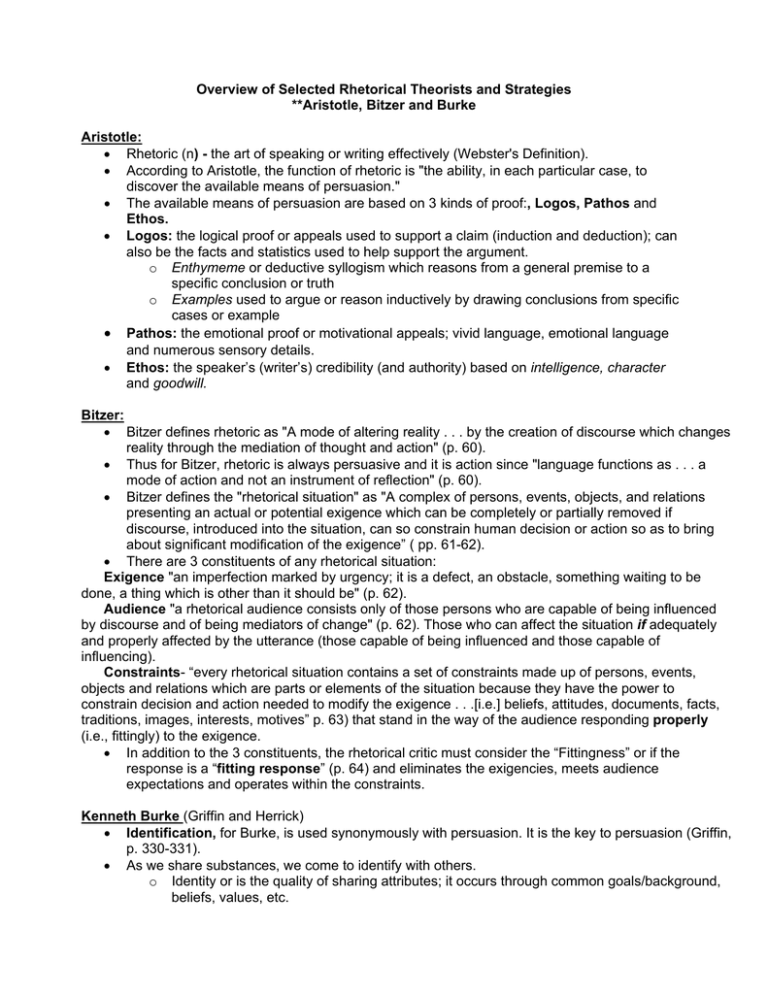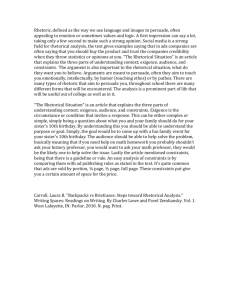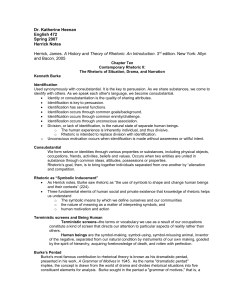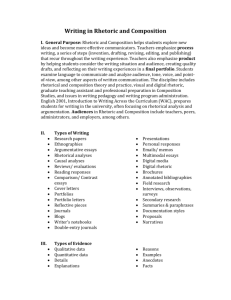Overview of Selected Rhetorical Theorists and Strategies **Aristotle, Bitzer and Burke Aristotle:
advertisement

Overview of Selected Rhetorical Theorists and Strategies **Aristotle, Bitzer and Burke Aristotle: • Rhetoric (n) - the art of speaking or writing effectively (Webster's Definition). • According to Aristotle, the function of rhetoric is "the ability, in each particular case, to discover the available means of persuasion." • The available means of persuasion are based on 3 kinds of proof:, Logos, Pathos and Ethos. • Logos: the logical proof or appeals used to support a claim (induction and deduction); can also be the facts and statistics used to help support the argument. o Enthymeme or deductive syllogism which reasons from a general premise to a specific conclusion or truth o Examples used to argue or reason inductively by drawing conclusions from specific cases or example • Pathos: the emotional proof or motivational appeals; vivid language, emotional language and numerous sensory details. • Ethos: the speaker’s (writer’s) credibility (and authority) based on intelligence, character and goodwill. Bitzer: • Bitzer defines rhetoric as "A mode of altering reality . . . by the creation of discourse which changes reality through the mediation of thought and action" (p. 60). • Thus for Bitzer, rhetoric is always persuasive and it is action since "language functions as . . . a mode of action and not an instrument of reflection" (p. 60). • Bitzer defines the "rhetorical situation" as "A complex of persons, events, objects, and relations presenting an actual or potential exigence which can be completely or partially removed if discourse, introduced into the situation, can so constrain human decision or action so as to bring about significant modification of the exigence” ( pp. 61-62). • There are 3 constituents of any rhetorical situation: Exigence "an imperfection marked by urgency; it is a defect, an obstacle, something waiting to be done, a thing which is other than it should be" (p. 62). Audience "a rhetorical audience consists only of those persons who are capable of being influenced by discourse and of being mediators of change" (p. 62). Those who can affect the situation if adequately and properly affected by the utterance (those capable of being influenced and those capable of influencing). Constraints- “every rhetorical situation contains a set of constraints made up of persons, events, objects and relations which are parts or elements of the situation because they have the power to constrain decision and action needed to modify the exigence . . .[i.e.] beliefs, attitudes, documents, facts, traditions, images, interests, motives” p. 63) that stand in the way of the audience responding properly (i.e., fittingly) to the exigence. • In addition to the 3 constituents, the rhetorical critic must consider the “Fittingness” or if the response is a “fitting response” (p. 64) and eliminates the exigencies, meets audience expectations and operates within the constraints. Kenneth Burke (Griffin and Herrick) • Identification, for Burke, is used synonymously with persuasion. It is the key to persuasion (Griffin, p. 330-331). • As we share substances, we come to identify with others. o Identity or is the quality of sharing attributes; it occurs through common goals/background, beliefs, values, etc. • Division, or lack of identification, is the natural state of separate human beings. o The human experience is inherently individual, and thus divisive. o Rhetoric is intended to replace division with identification. Rhetoric as “Symbolic Inducement” • Burke saw rhetoric as “the use of symbol to shape and change human beings” (Herrick, p. 224225). o Symbols are the essence of existence, the means by which we define/understand ourselves and our world. o Every set of symbols becomes a screen though which we perceive the world. o Language does not just “reflect” reality; it “selects” reality. Thus language directs us toward seeing some things and ignoring others. Dramatism and Function of the Pentad (Herrick and Griffin) • Burke uses this “metaphor" to explain human motivation through the analysis of drama. It is a technique of analysis of language and of thought as basically modes of action. It is used as a method of analysis to ascertain the motivation in symbolic action. • Burke recommend content analysis of key terms (god term for what the speaker considers positive and devil term for what the speaker regards as wrong or evil). • The five elements of the pentad are: 1. the act—is what was done or is being done 2. the scene— the location of the act ; its setting 3. the agent— the person performing the action 4. agency— the means by which the agent performs the act, and 5. purpose—the reason for the action, the intended goal. • The pentad offers a way to determine why the speaker selected a given rhetorical strategy to identify with the audience. Pentadic Ratios: o Pentadic ratios describe relationships between elements of the pentad. o Pentadic ratios can be used to determine the appropriateness of certain components of rhetoric. • Ratios suggest a relationship of propriety, suitability, or requirement among the elements. • By examining or evaluating the ratio of importance between pairs, the rhetorical critic can determine which element provides the best clue to the speaker’s motivation. **Sources: The Rhetoric of Aristotle by Em Griffin. First Look at Communication Theory 6th edition, McGraw-Hill, 2006, pp 319-327. The Rhetorical Situation by Lloyd F. Bitzer Readings in Rhetorical Criticism ed, Carl Burgchardt, State College: Strata Publishing, 1995, pp 58-67. Dramatism of Kenneth Burke by Em Griffin. First Look at Communication Theory 6th ed., McGrawHill, 2006, pp 330-337. Contemporary Rhetoric II: The Rhetoric of Situation, Drama and Narration by James A. Herrick. The History and Theory of Rhetoric Scottsdale, AZ, [Gorsuch Pub.], pp 223-231. Evaluating and Criticizing the Speeches of Others by Douglas Ehninger, Alan H. Monroe, Bruce E. Gronbeck Principles and Types of Speech Communication Dallas, Scott, Foresman & Co, 1978, pp 433-443.






